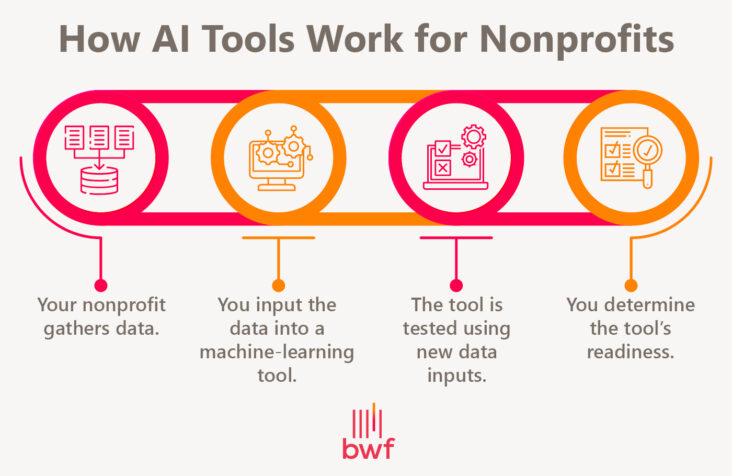How to Use AI Fundraising Tools to Boost Donor Engagement

Artificial Intelligence (AI) fundraising may seem like no more than the newest philanthropy buzzword. In reality, many nonprofits like St. Jude Children’s Research Hospital have already been using AI solutions to streamline their workflows and increase efficiency, and AI usage will only grow moving forward.
If your nonprofit is ready to dive deeper into the world of AI fundraising to boost donor engagement with your mission, this is the place to start! In this guide, we’ll review the basics of AI fundraising tools and a few strategies for using these solutions to improve donor relationships.
How AI Fundraising Tools Work
There are many types of AI fundraising tools that suit a wide range of needs. You may be most familiar with generative AI tools like ChatGPT, Bard, and DALL-E. Other AI solutions nonprofits commonly use include chatbots or virtual assistants to help streamline manual work.
Some of the most helpful solutions for fundraising are data processors like IBM Watson or Google Cloud AI. These solutions leverage predictive analytics to help anticipate future donor actions.
According to BWF’s AI for nonprofits guide, the process of using these predictive AI fundraising tools looks like this:

- Your nonprofit gathers data using sources like your online donation form, donor feedback surveys, and website analytics.
- You add the data to a machine-learning solution, which uses the information to learn about your donor base.
- Your team tests the new solution with new data points to see how it responds and the accuracy of its outputs.
- Your nonprofit determines whether the tool can deliver accurate, helpful insights and whether it’s ready to be used in future fundraising campaigns. You’ll further test and refine the tool over time the more you use it to support your fundraising.
When trained properly, data processing AI tools can improve your nonprofit’s fundraising effectiveness by allowing you to focus more of your attention on donors with a high giving capacity and likelihood of long-term involvement. These solutions can also help you develop personalized strategies that speak to each donor’s unique needs and interests based on their past interactions with your organization.
3 Ways to Use AI Tools to Enhance Donor Experience
Improving the donor experience starts with using the right AI fundraising strategies and keeping your focus on donors’ preferences. Here are three strategies to leverage generative and data processing AI solutions to boost donor engagement:
1. Create personalized marketing outreach plans
Using AI, you can personalize donor outreach quickly and easily, scaling up your efforts to reach donors at all levels. Specifically, AI solutions can support the following aspects of personalization:
Segmenting donors
Data processing AI solutions can help segment your supporters into different groups based on the characteristics they have in common. For example, you could create segments based on:
- How frequently donors give (monthly, yearly, quarterly, infrequently)
- Donors’ preferred communication platforms (email, social media, direct mail, phone calls, in-person chats)
- Donors’ giving amounts (small, mid-tier, major)
Then, you can use these segments to create marketing materials tailored to the interests of each group. For example, small and mid-tier donors might be interested in hearing about your annual crowdfunding campaign, while major donors may want more information about your planned or legacy giving program.
Developing personalized messaging for different segments
Use targeted AI prompts to help develop content that specifically appeals to different groups. For example, we asked ChatGPT to “Come up with three different ideas for an email subject line for an email series about a summer fundraising initiative. The subject lines should be targeted toward an occasional donor, a monthly donor, and an annual donor.”
Here’s what we got in response:
- For the Occasional Donor:
- Subject: “Make This Summer Shine: Join Our One-Time Summer Giving Fest!”
- For the Monthly Donor:
- Subject: “Your Monthly Support Sparks More Than Ever This Summer!”
- For the Annual Donor:
- Subject: “Annual Heroes of Summer: Elevate Your Impact in Our Special Summer Drive!”
You can use generative solutions to help draft full email messages, text messages, blog post outlines, direct mail letters, and more. Remember to edit the responses you receive from these tools to align with your organization’s brand and tone.
2. Anticipate donors’ future behavior
As mentioned, AI solutions can evaluate historical donor data to help predict donors’ future behaviors. By leveraging an AI solution, you can determine each donor’s:
- Likelihood of giving again
- Predicted next donation amount
- Projects or programs they prefer to give to
- Giving capacity
- Likelihood of becoming a major or planned donor
This data will help you craft outreach that meets each supporter’s unique needs. For example, let’s say you’re stewarding a mid-level donor that you think has the potential to become a major donor. Using your AI solutions, you determine this donor is highly likely to give again because they’ve been very engaged with your organization’s emails and recent events. Through prospect research, you see that this individual has contributed $8,000 to a similar nonprofit in the past.
Your AI tools also show you that the donor is particularly interested in your volunteer program because of a history of donations to campaigns that support that program. With this information, you set up a meeting with this individual to thank them for their previous involvement, highlight the impact they’ve had so far, and ask if they’d be willing to contribute a $10,000 donation to benefit your volunteers. The prospect will be much more likely to respond positively when they see that you’ve done the necessary work to understand them on a personal level.
3. Track donors’ engagement
AI tools can help measure supporters’ feelings and opinions about your nonprofit by gathering data from surveys, polls, forms, and marketing engagement metrics like email opens or social media likes. You can use this information to identify trends and patterns in donor sentiment.
For example, let’s say you want to know how donors feel about your nonprofit’s annual giving email outreach. You might send a feedback survey to donors at all levels and track email open rates for messages related to this campaign.
Create a plan to incorporate donors’ feedback where you can, and let donors know how you’re taking their responses into account when planning upcoming initiatives. This shows donors that your nonprofit is willing to listen to their feedback and incorporate their preferences into your future activities.
When it comes to machine learning solutions, go slowly and start small. These tools are evolving every day, and it’s important to align your AI strategies with your nonprofit’s values and your donors’ preferences. Consider working with a professional AI fundraising consultant to develop a customized approach that resonates with your unique donor base while maintaining trust.

